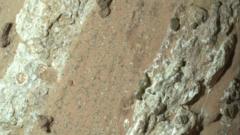Recent geological observations on the Red Planet have uncovered distinctive mudstone formations, presenting a compelling new avenue in the enduring quest for evidence of extraterrestrial life. These unique rocks, characterized by what researchers describe as a “leopard-spot” pattern, are now under intense scrutiny by the scientific community.
Scientists are exploring the possibility that these unusual mudstones could be directly linked to ancient Martian microbes. The specific textural features and composition of these formations prompt comparisons to similar geological structures found on Earth, which are often associated with fossilized microbial activity. On our home planet, such patterns in sedimentary rocks can serve as biosignatures, indicating environments where microscopic life once thrived, influencing the very structure of the rock.
The discovery holds significant implications for understanding Mars’s past habitability. If these “leopard-spot” mudstones indeed point to biogenic origins, they would represent the most substantial clue yet that primitive life once existed on Mars. Researchers are focusing on detailed analysis to determine the exact conditions under which these rocks formed and whether their peculiar appearance is a result of biological processes. This ongoing investigation aims to unravel a crucial chapter in the Red Planet’s history, potentially redefining our understanding of life’s presence beyond Earth.



